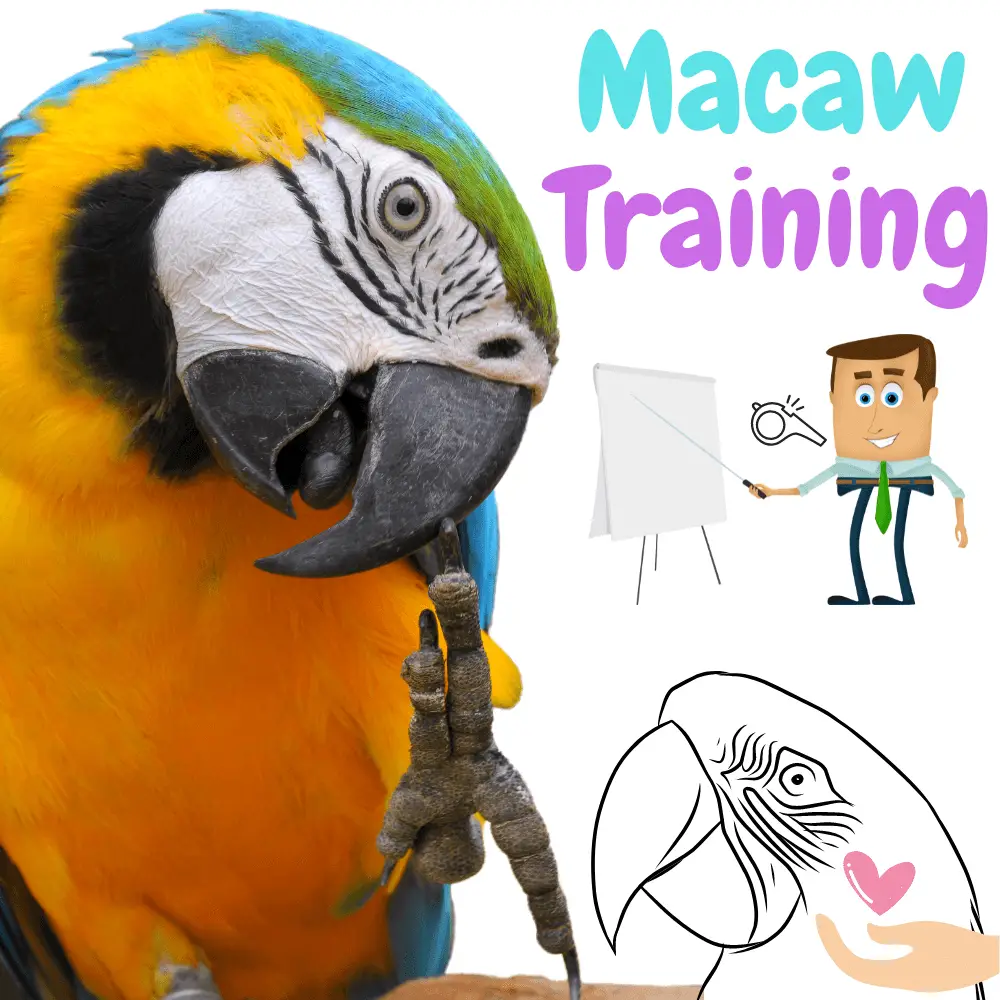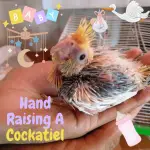
Macaw training: you finally got this big and beautiful parrot that we call a macaw. She is weaned, her hand feeding is finished, and she is just starting to get used to the cage and perch regularly.
And now?
It’s time to form your love to help it become the best thing since sliced bread.
Basic training rules for a macaw
Never hit your bird. If you do, you might as well take the bird back to the store and buy a new one, because you have broken the trust.
Always use positive reinforcement. If your macaw doesn’t do what they’ve been asked to do, don’t say anything or offer a treat.
Make sure all your movements are slow and deliberate. Never sneak on your bird. By making your movements slow, your macaw will be able to follow and learn faster.
Keep sessions short. 15-20 minutes of training is enough. Do not hesitate to do two sessions a day; Just be sure to distribute them.
Try not to take a day off. Training of trainers is based on consistent training every day
Your reward should be easy to eat. If your reward is a huge nut, the time you have to wait for your feathered friend to break and eat it is wasted. Use something that doesn’t need to be broken and easily breaks into small pieces.
Make eye contact. It sounds silly, but it works. This doesn’t mean you have to do a look contest, but your bird will try to impress you more by going around if it sees your eyes.
Practice on a perch or table in a windowless room and, if possible, with very little decoration on the wall. Essentially, keep distractions to a minimum. Don’t use music. Turn off the TV. If you don’t have a room without windows, at least lower the blinds on the windows. Training will be easier if your bird is 100% focused on you.
Praise the effort, and praise + treat the success. Training guides say to hold your tongue when the macaw doesn’t do the trick. I disagree. In my experience, giving a little “atta boy!” is a much-needed booster. Don’t forget to make a big deal out of it when your feathered friend finally goes around; Let him or her know that he or she did it!
Work on only one lathe at a time. Your feathered friend is smart, but not to this extent.
Macaw Training

Macaw training step one?
I’m glad you asked. The first “lesson” I teach all my parrots, including my grays, macaws, cockatoos, etc., is socializing with the human herd, as I call it. With five people living in my home, it’s important to create a well-balanced, family-like bird. A little cooperation from the family makes it easy to achieve this. Most macaws have no problem raising and do not need to be trained to do so. It is enough for each member of the family to hold the bird for a few minutes a day and offer it a treat to create a family bird. In my experience, most don’t just cling to mom or dad. In a few weeks, she will no longer be afraid to put herself on someone’s arm.
Also, remember that a macaw, or any bird for that matter, will always “test” the arm before getting up. This involves the bird leaning over your arm and checking it before making its final decision. Don’t panic, he’s not trying to bite you!
When all else fails and the macaw is a little shy, do not hesitate to use the push-up technique. Just push it on your stomach with your arm, forcing your feathered friend to stand up. Most birds will not mind.
Macaw training

Teaching your macaw to speak
Macaws have the ability to learn dozens of words and short phrases during their lifetime. What most people don’t know about these wonderful animals is how they learn. Most parrots that can speak pick up both sound and tone as they listen. This means that if you say “hello” in a high-pitched voice, the bird associates the word with its tone. The next day, if you say “hello” in a deep, rumbling voice, you have made no progress, because your macaw expects to hear “hello” in a high-pitched tone.
Stick to one word at a time in the final days of your training. Once your macaw has learned a word or two, it becomes much easier to learn more. It should only take a week (or even less) per word.
Repetition is key
Teaching your bird to speak is so simple. Every time you pass by the cage or come into contact with it, just look into her eyes and say the word. At first, she will stare at you as if you were a Medusa. Soon his pupils will become small; That’s a good sign. Dilated pupils are normal, but when a macaw speaks, the pupils become tiny and its head moves a little. This is evident in a young bird, but an adult has naturally small pupils, so it is less noticeable.
One day, you will pass by and let out your usual “hello”. The next day, a cute little “hello” comes back to you shouting! That’s all.
Two tips:
Choose the words carefully. Your bird will remember it for the rest of its life.
I am not suggesting using a voice recorder. Have you ever seen what happens when the phone rings? My birds get nervous and scream. That’s because it’s a loud and obnoxious sound that they can’t locate. A macaw has nothing against sounds, really, as long as it knows where it comes from. The general ringing of a phone or door scares them. Unless you want to place the voice recorder directly in front of his face, don’t bother. I don’t recommend it either, because teaching your macaw to talk improves your relationship. The recorder only gets in your way.
What does it mean when my macaw’s pupils become small?
Eye pinning (also called “blinking”) means that the bird is excited. If something excites him, it catches his attention. Small pupils indicate that the bird is in a perfect state of mind for learning.
Bringing them to heel and the wave
The two most common and easiest tricks are the “stick ’em up” and the “wave”.
The “stick’em up” is a trick where the man pretends to have a weapon and says “stick’em up” or “freeze”, and the bird raises its wings like a man raising his hand. It’s a trick that looks stupid and will make any observer laugh. The bird raises a wing, imitating a human arm waving.
So, first of all, teach him how to stick them, which will allow him to make an easy wave. Each time she raises her wings to stretch, simply pull out your “weapon”, tell her to raise them, and offer her a treat. Once you teach him this, the wave will come naturally: Say “salute” and ask him to put one of his wings. Congratulations and rewards.
Macaw Play Basketball
This is my favorite trick! It is also very difficult and very long. In this round, your feathered friend puts a blowpipe ball in a small basketball hoop. Here are the steps to success:
Gather materials: About half a dozen whipping balls (all the same color), a mini basketball hoop (Google them, there are everywhere), a practice table at waist height, one of the food bowls, and lots of treats!
Get your macaw used to baseball. Throw one or two balls into the cage. It is very likely that the next morning, both balls will be in tatters. It’s okay, you have more! If you’re having trouble getting your macaw used to the ball, try putting a treat inside the ball.
Then teach the bird to play basketball with the food bowl. Depending on your macaw, the food bowl is the most valuable item. Give the bird a basketball and put a treat in an otherwise empty food bowl on the practice table. Instinct gets involved and the little bird trotted toward the bowl of food.
If he drops the ball on his way to the bowl, move the food bowl to the other side of the table, return the ball to him, and do not congratulate him. After a few unsuccessful attempts, give the treat to Birdy (no need to be cruel).
After a week or two of workouts a day, Birdy will finally put the ball in the bowl and claim the treat in the right way. Once she does, the ball is etched into her head, and the next step is done naturally.
Now put the food bowl on the edge of the hoop. A standard-sized food bowl should fit snugly. The first time Birdy sees the hoop, she can run toward the hills. Mine charged and dropped it: It’s completely normal, just give your macaw some time. I went to extremes and put the hoop in Gracie’s cage.
After only a few hours, it became a toy! Once she is no longer afraid of the hoop, she graciously and willingly puts the ball in the food bowl. This step can take between one and two weeks to learn.
The last step is to remove the food bolus and complete the process. The key to this step is the treat. If she misses or drops the ball, give her the ball back and don’t congratulate her (but after a few tries, give her a treat, so as not to be cruel). This step can take from a few days to a few weeks.
Let us hope that these measures will allow it to take a big step forward!
Macaw Training

Recall Training
Rappel training involves teaching your bird to fly on command. This is an advanced trick that should only be attempted by experienced owners. Do not tempt it outside. These steps worked for me in just three weeks:
Take a perch on the chest up to the shoulders.
Start small by placing your arm about a foot from the perch. Your macaw should be able to climb the perch without jumping. Do it once or twice.
Then grab a treat and hold it behind your arm. Move just out of reach of the perch, forcing Birdy to literally jump. You may have to wait a few minutes, but Birdy will eventually make the bold leap. Encouragement treats and your command will help Birdy along the way. This step must be done for a few days to give him confidence.
After making the small leap with confidence, begin to back up slowly, one foot at a time.
Teach him to fly on command by saying “come [bird’s name]” and offering him a treat.
Good luck!
Macaw Training Basics
SOURCE:BirdTricks




















